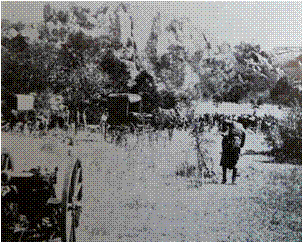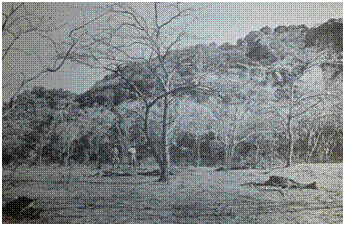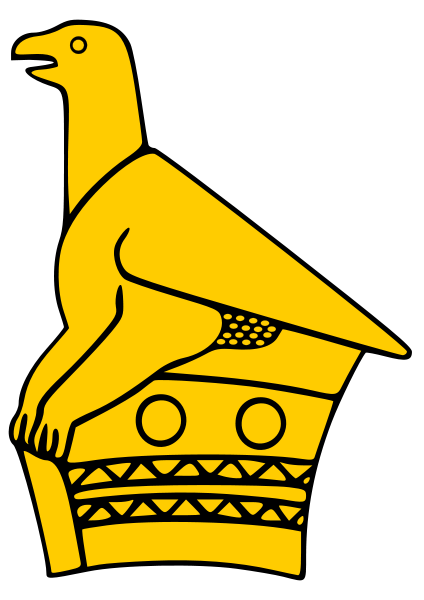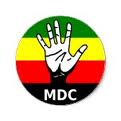Pioneer Days
The Matabele took the initiative...

The laager at Inungu
Mabiza, Dhliso and Hole were commanding the Amabuto and Igapa regiments and in the best of Matabele traditions, decided to launch an early morning attack from the south. The idea was to launch a feint on the northern side of the laager and when the whites were fully engaged launch a full-scale assault on their exposed rear. It very nearly worked if it were not for the personal fortitude of Tyrie Laing.
How did the whites survive?
At 0530 “Boot and Saddle” was sounded and as Laing (1897: 285) relates, “The last note had hardly left the bugle when a rifle shot was fired from our rear and a bullet whistled harmlessly over the laager. Immediately after the shot came the battle-cry and yells that are the inevitable accompaniment of a Matabele charge”. Halkett's (1971) memory of the battle is vivid:
By jove it was simply awful the row that was going on, what with the enemy chanting as they advanced, our horses snorting and the roar of musketry. For the first fifteen minutes, we could see nothing but the flash of their rifles as they fired into us from their strong natural defences, ridges of rock and bush. All we did was to watch for a flash and cover it immediately and patiently await the next one and then let rip.
There was no panic and Laing seemed to be everywhere reassuring his men and acting as an oasis of calm. The Matabele showed their usual impressive and suicidal regard for their own safety, charging into the blazing fire of the rifles, machine guns and seven-pounder. Laing recalled they almost made it into the laager; indeed bodies were collected no less than four metres from the laager. The Matabele diversion nearly worked and it was only the cool use of a Maxim gun by Sergeant Hopper that saved the day, laying down “a steady and destructive fire”.
Maciti blekfasti!

Scene of the fight at Laing's graveyard, showing the bodies of dead horses
The friendlies were ensconced in a separate laager and when the attack started they panicked. Rushing towards the white's laager they saved the day by drawing the full wrath of the attacking warriors. Stabbing and hacking at these unfortunate souls, the Matabele lost their impetus and the whites were able to bring their heavy guns into play and hold their line. After this and for almost two hours, the battle settled down to a gun duel, the Matabele firing steadily from behind cover. Indeed one man named Hukutsa was known to have claimed four lives before his was in turn ended by a bullet between the eyes. Laing sent what was left of his friendlies to rout the Matabele in the northern side of the laager and once they succeeded, the battle was over. Mabiza was forever known by the praise name of “Maciti blekfasti” (He spoiled their breakfast) after this fight, a name he carried with pride. Losses were 90 dead. The whites retreated back to Fort Usher to await orders. Laing (1897: 294-296) claimed it was the “stiffest fight I have ever been in... I must confess that during the first hour and a half I was at a loss to know what the upshot was to be... The fight at Shangani and Bembesi during the compaign [sic] of occupation in 1893 were, in my opinion, mere flea bites compared with Inugu”.
Did this setback change Imperial strategy?
Two setbacks in one day were not enough to convince Plumer to alter his strategies. Deciding those responsible for Laing's battle needed to be punished, he sent Nicholson with 250 white soldiers, 200 Cape Boys and a great deal of heavy weaponry. Nicholson took Laing's line of march but camped near Efifi then sent his men into Inungu gorge to force battle with the Matabele. Johann Colenbrander (see briefing on the Indabas) led the levies into battle but after losing several men, withdrew back to the laager site with ten of his men killed for two enemy dead. Confidence in a quick campaign was ebbing fast and the BSACo was in deep trouble; Carrington wanted a vast number of Imperial troops brought in at the company's expense; he wrote that for the 1897 campaign he would ask for a further 2500 white infantry, a team of engineers for blasting operations, two to four mountain guns and 2000 carriers. Sykes (1897: 185), as ever, gave the best précis of the challenge:
The question of wiping out the rebels appeared to resolve itself into a simple mathematical problem: If to every ten rebels killed or disabled one white man is killed or disabled, how many of Plumer's Column, 500 strong, will remain by the time the 5,000 rebels in the hills are killed or disabled?... The rebels held the key to the situation, and they knew it well.
A final showdown was desired and Plumer, perhaps pressured by Rhodes's amply expressed horror at the proposed Imperial intervention, thought he could force the confrontation to his advantage.
Sourced from the Zanj Financial Network 'Zfn', Harare, Zimbabwe, email briefing dated ? 2011


 South Devon Sound Radio
South Devon Sound Radio Museum of hp Calculators
Museum of hp Calculators Apollo Flight Journal
Apollo Flight Journal Apollo Lunar Surface Journal
Apollo Lunar Surface Journal Cloudy Nights Classic Telescopes
Cloudy Nights Classic Telescopes The Savanna - Saffer Shops in London
The Savanna - Saffer Shops in London Linux Mint
Linux Mint Movement for Democratic Change
Movement for Democratic Change